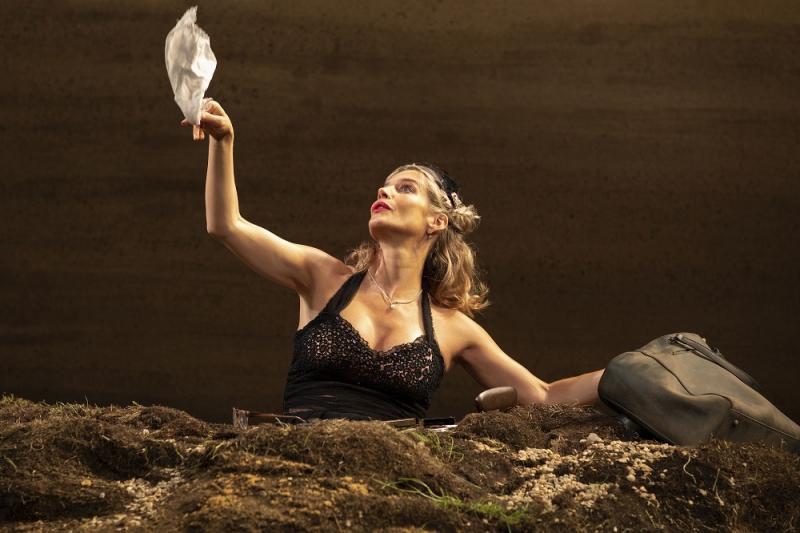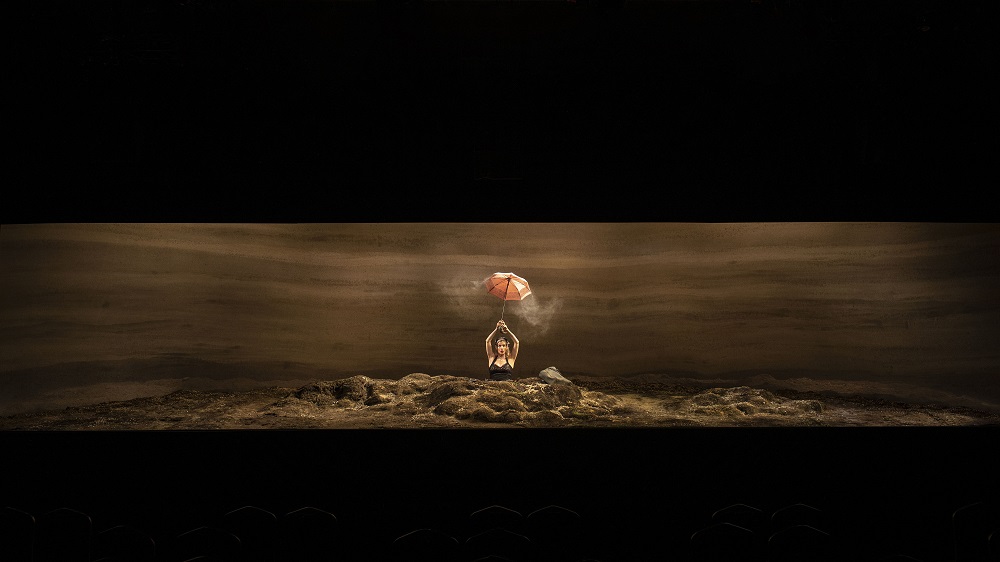Happy Days, Riverside Studios review - memory, madness and melancholy | reviews, news & interviews
Happy Days, Riverside Studios review - memory, madness and melancholy
Happy Days, Riverside Studios review - memory, madness and melancholy
Lisa Dwan’s infinite variety guides us through Beckett’s timeless masterpiece

Just when you thought you couldn’t take any more one- or two-handers, online or in the theatre, along comes the supreme masterpiece to jolt you out of any fatigue. Every line counts as Winnie, buried up to her waist and then up to her neck, determines that words will never fail her. And what poetry there is in even the most banal observation, the endless repetition.
The initial vision of Trevor Nunn’s production is a coup in itself. We’re seated, in twos and threes but numerously, on the level of the theatre space, wondering how well we’re going to see. Blackout, lights up – an oblong high up. Surreal beyond Beckett’s definition of “a pathetic unsuccessful realism, the kind of tawdriness you get in a third rate musical pantomimie”, Rob Jones’s design burns itself on the mind’s eye.  There, of course, in the middle, is Dwan’s Winnie – still “well-preserved…big bosom” as Beckett asks her to be. The bright everydayness of her chatter belies what’s to come. We admire her heroic pursuit of the lettering on a toothbrush, her observation that “not a day goes by - hardly a day without some addition to one’s knowledge however trifling, the addition I mean, provided one takes the pains.” We’re touched by whatever she gets out of grunting Willie (Simon Wolfe) behind the mound: “what a happy day for me..it will have been. So far”.
There, of course, in the middle, is Dwan’s Winnie – still “well-preserved…big bosom” as Beckett asks her to be. The bright everydayness of her chatter belies what’s to come. We admire her heroic pursuit of the lettering on a toothbrush, her observation that “not a day goes by - hardly a day without some addition to one’s knowledge however trifling, the addition I mean, provided one takes the pains.” We’re touched by whatever she gets out of grunting Willie (Simon Wolfe) behind the mound: “what a happy day for me..it will have been. So far”.
There’s physical beauty, too, in Dwan’s gestures – more than a match for Beckett’s detailed stage instructions. That only makes the second act all the more shocking. The terrifying chalked face, the hair: it’s probably wise that no publicity photos have been supplied of the look. In this even more phantasmagorical transformation, Beckett revisits themes in truncated form (so musical, but no opera could or should be made of this, and Nunn, unusually for him, wisely refrains from music at any point). At first we feel language has broken down – Dwan articulates the monosyllables as if in a trance, a terrible recreation of senile dementia. But then a new story emerges, and shared memories with Willie, who makes his last, surprising emergence. What a use of language, after Lewis Carroll and Joyce; and what a delivery of it. If this role is for women what Hamlet is for men (and women too, of course), then Dwan has scaled the mountain with fearless and infinitely diverse aplomb.
rating
Explore topics
Share this article
The future of Arts Journalism
You can stop theartsdesk.com closing!
We urgently need financing to survive. Our fundraising drive has thus far raised £49,000 but we need to reach £100,000 or we will be forced to close. Please contribute here: https://gofund.me/c3f6033d
And if you can forward this information to anyone who might assist, we’d be grateful.

Subscribe to theartsdesk.com
Thank you for continuing to read our work on theartsdesk.com. For unlimited access to every article in its entirety, including our archive of more than 15,000 pieces, we're asking for £5 per month or £40 per year. We feel it's a very good deal, and hope you do too.
To take a subscription now simply click here.
And if you're looking for that extra gift for a friend or family member, why not treat them to a theartsdesk.com gift subscription?
more Theatre
 Macbeth, RSC, Stratford review - Glaswegian gangs and ghoulies prove gripping
Sam Heughan's Macbeth cannot quite find a home in a mobster pub
Macbeth, RSC, Stratford review - Glaswegian gangs and ghoulies prove gripping
Sam Heughan's Macbeth cannot quite find a home in a mobster pub
 The Line of Beauty, Almeida Theatre review - the 80s revisited in theatrically ravishing form
Alan Hollinghurst novel is cunningly filleted, very finely acted
The Line of Beauty, Almeida Theatre review - the 80s revisited in theatrically ravishing form
Alan Hollinghurst novel is cunningly filleted, very finely acted
 Wendy & Peter Pan, Barbican Theatre review - mixed bag of panto and comic play, turned up to 11
The RSC adaptation is aimed at children, though all will thrill to its spectacle
Wendy & Peter Pan, Barbican Theatre review - mixed bag of panto and comic play, turned up to 11
The RSC adaptation is aimed at children, though all will thrill to its spectacle
 Hedda, Orange Tree Theatre review - a monument reimagined, perhaps even improved
Scandinavian masterpiece transplanted into a London reeling from the ravages of war
Hedda, Orange Tree Theatre review - a monument reimagined, perhaps even improved
Scandinavian masterpiece transplanted into a London reeling from the ravages of war
 The Assembled Parties, Hampstead review - a rarity, a well-made play delivered straight
Witty but poignant tribute to the strength of family ties as all around disintegrates
The Assembled Parties, Hampstead review - a rarity, a well-made play delivered straight
Witty but poignant tribute to the strength of family ties as all around disintegrates
 Mary Page Marlowe, Old Vic review - a starry portrait of a splintered life
Tracy Letts's Off Broadway play makes a shimmeringly powerful London debut
Mary Page Marlowe, Old Vic review - a starry portrait of a splintered life
Tracy Letts's Off Broadway play makes a shimmeringly powerful London debut
 Little Brother, Soho Theatre review - light, bright but emotionally true
This Verity Bargate Award-winning dramedy is entertaining as well as thought provoking
Little Brother, Soho Theatre review - light, bright but emotionally true
This Verity Bargate Award-winning dramedy is entertaining as well as thought provoking
 The Unbelievers, Royal Court Theatre - grimly compelling, powerfully performed
Nick Payne's new play is amongst his best
The Unbelievers, Royal Court Theatre - grimly compelling, powerfully performed
Nick Payne's new play is amongst his best
 The Maids, Donmar Warehouse review - vibrant cast lost in a spectacular-looking fever dream
Kip Williams revises Genet, with little gained in the update except eye-popping visuals
The Maids, Donmar Warehouse review - vibrant cast lost in a spectacular-looking fever dream
Kip Williams revises Genet, with little gained in the update except eye-popping visuals
 Ragdoll, Jermyn Street Theatre review - compelling and emotionally truthful
Katherine Moar returns with a Patty Hearst-inspired follow up to her debut hit 'Farm Hall'
Ragdoll, Jermyn Street Theatre review - compelling and emotionally truthful
Katherine Moar returns with a Patty Hearst-inspired follow up to her debut hit 'Farm Hall'
 Troilus and Cressida, Globe Theatre review - a 'problem play' with added problems
Raucous and carnivalesque, but also ugly and incomprehensible
Troilus and Cressida, Globe Theatre review - a 'problem play' with added problems
Raucous and carnivalesque, but also ugly and incomprehensible
 Clarkston, Trafalgar Theatre review - two lads on a road to nowhere
Netflix star, Joe Locke, is the selling point of a production that needs one
Clarkston, Trafalgar Theatre review - two lads on a road to nowhere
Netflix star, Joe Locke, is the selling point of a production that needs one

Add comment